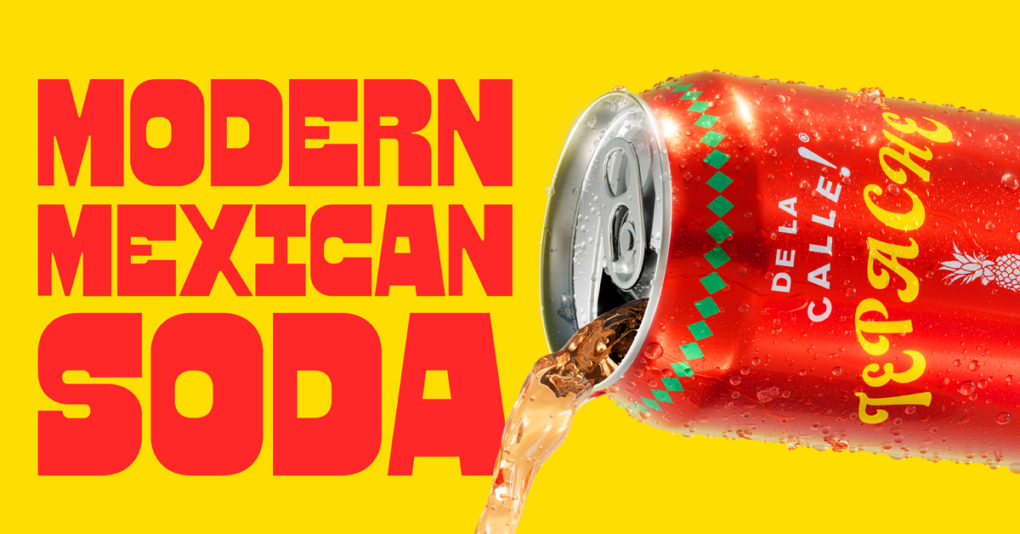Since launching in 2021, Los Angeles-based tepache brand De La Calle has been working to bring a classic Mexican beverage to the U.S. market. Now repositioned as a “Modern Mexican Soda,” the brand is intent on bringing more Hispanic consumers into the fold.
Founded by entrepreneurs Alex Matthews and Rafael Martin Del Campo and developed in part through Matthews’ agency, HERE Studio, De La Calle has always aimed to be a modernized take on tepache, a traditional beverage with roots in pre-Columbian Mexico made from fermented pineapple rinds and sugar.
According to Matthews, the company understood early on that it would need to invest heavily in U.S. consumer education for the brand to grow, but while the tepache category remains niche (although that’s not to discount some recent entrants, including kombucha maker Humm) De La Calle’s new design seeks to align the brand with Mexican sodas while serving as a better-for-you alternative to brands like Jarritos (Novamex), or even American brands popular in Latino communities like Fanta.
“The brand has spent an extended amount of time, three and a half years really, educating consumers and talking to folks about the benefits of tepache,” Matthews said. “The lightbulb moment for us came late last year when we decided ‘Hey, maybe it’s time for us to peel back the layers here and start to think about how could we make tepache a much bigger platform.’”
Debuting this month, new packaging and marketing campaigns feature the phrase “Modern Mexican Soda.” As well, Matthews said the company has been regularly reformulating the drinks with higher quality ingredients, although the core flavors and nutritional attributes have remained largely unchanged. The brand is also lowering its price point from $3.29 per 12 oz. can to $2.49 in conventional accounts and $2.99 in the natural channel.
Although Matthews said De La Calle is the largest RTD tepache brand in the U.S., that only means it’s a large fish in a very small pond. Meanwhile, the broader soda category has seen a surge of attention and expansion as better-for-you brands like Poppi and Olipop rise to mainstream prominence and achieve triple-digit retail sales growth rates.
Matthews’ HERE Studio previously in 2022 launched a functional, better-for-you soda brand called Vina. However, when asked about the status of Vina, Matthews declined to comment.
For De La Calle, the focus now is on delivering a similar degree of disruption in a specialized segment of soda by focusing heavily on a demographic that Matthews admits the brand had been overlooking.
The brand, he said, had previously been positioned and marketed mainly to white consumers, focusing almost solely on natural channel retailers like Whole Foods and upscale foodservice accounts. De La Calle is in roughly 8,000 doors nationwide, including mass channel chains like Walmart and Target and conventional grocers such as select Kroger and Albertsons banners, but Matthews said the messaging and focus behind the brand wasn’t doing enough to speak to Latino consumers or reach them in areas with larger Hispanic populations.
Going forward, Matthews said the brand will still maintain those natural channel accounts while moving away from its premium position (hence the price cut) and working to expand its footprint into Hispanic grocery store chains independent specialty stores and restaurants.
“We are going to be able to start talking to and positioning ourselves to sell to Latinos,” Matthews said. “That community will be at around 25% of the U.S. population by 2028 and that buying power is in the trillions. So we know that there is a huge opportunity with our community – it needs very little education.”
The new focus also includes a pivot to De La Calle’s marketing strategy. While Matthews said the brand had seen solid growth through Instagram, it is now going all in on TikTok for its social media campaigns, releasing videos in both English and Spanish targeted directly to Latino consumers. Matthews said the brand will also employ digital and outdoor advertising, as well as a series of wrapped trucks in Southern California featuring the new messaging in both languages.
“The growth [on TikTok] is outstripping Instagram 10-to-one,” he added. “The community that’s on there is much more dialed in and interested in content that brands are putting out, but isn’t just branded content. So,on the De La Calle TikTok we’ll be featuring independent Mexican restaurants that we love, taquerias that we love, other products that we love.”
De La Calle’s shift towards reaching Latino consumers comes against the backdrop of calls from industry groups such as the Hispanic Marketing Council (HMC) or brands to do more to support Latino culture and consumers and to cease “Latino Coating” marketing practices which HMC chair Isabella Sanchez said, in a statement last week, offer the “illusion of inclusivity by adding Latino elements on the surface” without deeper substance or commitment to communities. This month, the group released a market guide urging companies to “prioritize the Hispanic market with intentional and authentic representation.”
